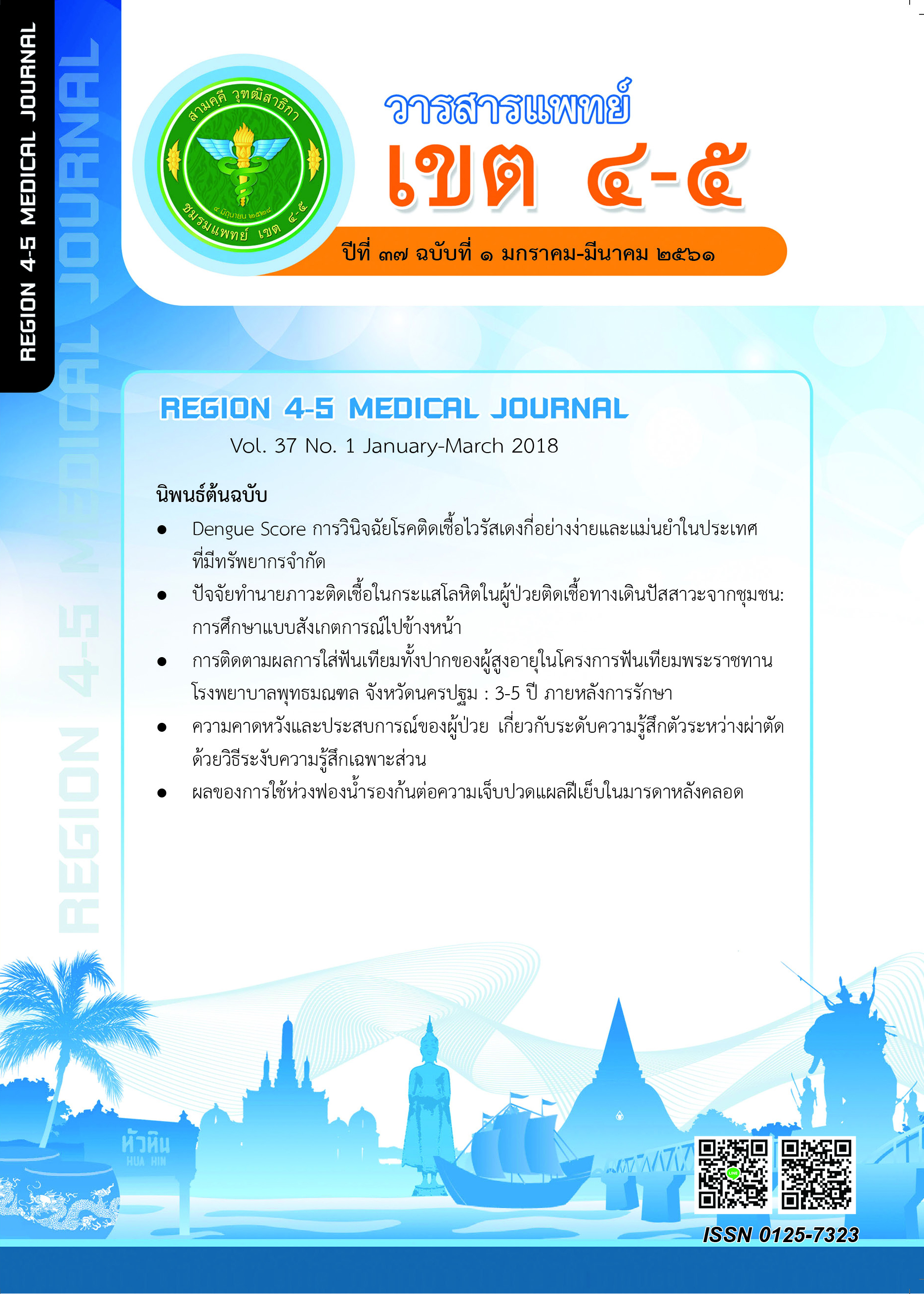ปัจจัยทำนายภาวะติดเชื้อในกระแสโลหิตในผู้ป่วยติดเชื้อทางเดินปัสสาวะจากชุมชน : การศึกษาแบบสังเกตการณ์ไปข้างหน้า
บทคัดย่อ
วัตถุประสงค์: เพื่อศึกษาลักษณะทางคลินิกและการตรวจทางห้องปฏิบัติการพื้นฐานในการทำนายภาวะติดเชื้อในกระแสโลหิต
วัสดุและวิธีการศึกษา: เป็นการศึกษาไปข้างหน้าในผู้ป่วย 106 ราย ที่เข้ารับการรักษาในโรงพยาบาลนครปฐม ระหว่างเดือนธันวาคม 2558 ถึงเดือนสิงหาคม 2559 กลุ่มตัวอย่างที่เลือกเข้าทำการศึกษา คือ ผู้ป่วยอายุมากกว่า 18 ปี มีไข้ ร่วมกับอาการของการติดเชื้อทางเดินปัสสาวะอย่างน้อย 1 อาการ และตรวจพบภาวะเม็ดเลือดขาวในปัสสาวะ ทำการวิเคราะห์ข้อมูลด้วยการวิเคราะห์การถดถอยโลจิสติกพหุนามเพื่อหาปัจจัยทางคลินิก และการตรวจทางห้องปฏิบัติการเพื่อหาปัจจัยทำนายภาวะติดเชื้อในกระแสโลหิตในผู้ป่วย
ผลการศึกษา: ผู้ป่วย 16 ราย (ร้อยละ 15) มีภาวะติดเชื้อในกระแสโลหิต ปัจจัยที่สัมพันธ์กับภาวะติดเชื้อในกระแสโลหิต ได้แก่ ระดับ C-reactive protein มากกว่าหรือเท่ากับ 20 มก/ดล. (adjusted OR = 10.8; 95%CI: 1.3, 93.4, p = 0.03) และ BUN/Cr ratio มากกว่าหรือเท่ากับ 16 (adjusted OR = 4.5; 95%CI: 1.1, 18.7, p= 0.04)
สรุป: C-reactive protein และ BUN/Cr ratio เป็นการตรวจที่ง่าย ทราบผลได้เลยตั้งแต่แรก สามารถนำมาใช้ทำนายการเกิดภาวะติดเชื้อในกระแสโลหิตในผู้ป่วยติดเชื้อทางเดินปัสสาวะจากชุมชน
เอกสารอ้างอิง
2. Foxman B. Epidemiology of urinary tract infections: incidence, morbidity, and economic costs. Dis Mon 2003;49(2):53-70.
3. Talan DA, Stamm WE, Hooton TM, et al. Comparison of ciprofloxacin (7 days) and trimethoprim-sulfamethoxazole (14 days) for acute uncomplicated pyelonephritis in women: a randomized trial. JAMA 2000;283(12):1583-90.
4. Velasco M, Martinez JA, Moreno-Martinez A, et al. Blood cultures for women with uncomplicated acute pyelonephritis: are they necessary? Clin Infect Dis 2003;37(8):1127-30.
5. Van Nieuwkoop C, Bonten TN, van‘t Wout JW, et al. Procalcitonin reflects bacteremia and bacterial load in urosepsis syndrome: a prospective observational study. Crit Care 2010;14(6):R206.
6. Chan UI, Kim HW, Noh YS, et al. A comparison of the clinical characteristics of elderly and non-elderly women with community onset non obstructive acute pyelonephritis. Korean J Intern Med 2015;30(3):372-83.
7. Lalueza A, Sanz-Trepiana L, Bermejo N, et al. Risk factors for bacteremia in urinary tract infections attended in the emergency department. Intern Emerg Med 2018;13:41-50.
8. Brown P, Ki M, Foxman B. Acute pyelonephritis among adults: cost of illness and considerations for the economic evaluation of therapy. Phamacoeconomics 2005;23(11):1123-42.
9. Lever A, Mackenzie I. Sepsis: definition, epidemiology, and diagnosis. BMJ 2007;335(7625):879-83.
10. Afshari A, Schrenzel J, leven M, et al. Bench-to-bedside review: Rapid molecular diagnostics for bloodstream infection - a new frontier? Crit Care 2012;16(3):222.
11. Grace CJ, Lieberman J, Piece K, et al. Usefulness of blood culture for hospitalized patients who are receiving antibiotic therapy. Clin Infect Dis 2001;32(11):1651-5.
12. Hsu CY, Fang HC, Chou KJ, et al. The clinical impact of bacteremia in complicated acute pyelonephritis. Am J Med Sci 2006;332(4):175-80.
13. Bahagon Y, Raveh D, Schlesinger Y, et al. Prevalence and predictive features of bacteremic urinary tract infection in emergency department patients. Eur J Clin Microbiol Infect Dis 2007;26(5):349-52.
14. Kofteridis DP, Papadimitraki E, Mantadakis E, et al. Effect of diabetes mellitus on the clinical and microbiological features of hospitalized elderly patients with acute pyelonephritis. J Am Geriatr Soc 2009;57(11):2125-8.
15. Kim KS, Kim K, Jo YH, et al. A simple model to predict bacteremia in women with acute pyelonephritis. J Infect 2011;63(2):124-30.
16. Chen CY, Chen YH, Lu PL, et al. Proteus mirabilis urinary tract infection and bacteremia: risk factors, clinical presentation, and outcome. J Microbiol Immunol Infect 2012;45(3):228-36.
17. Lee H, Lee YS, Jeong R, et al. Predictive factors of bacteremia in patients with febrile urinary tract infection: an experience at a tertiary care center. Infection 2014;42(4):669-74.
18. Lee CC, Wu CJ, Chi CH, et al. Prediction of community-onset bacteremia among febrile adults visiting an emergency department: rigor matters. Diagn Microbiol Infect Dis 2012;73(2):168-73.
ดาวน์โหลด
เผยแพร่แล้ว
รูปแบบการอ้างอิง
ฉบับ
ประเภทบทความ
สัญญาอนุญาต
ลิขสิทธิ์บทความเป็นของผู้เขียนบทความ แต่หากผลงานของท่านได้รับการพิจารณาตีพิมพ์ลงวารสารแพทย์เขต 4-5 จะคงไว้ซึ่งสิทธิ์ในการตีพิมพ์ครั้งแรกด้วยเหตุที่บทความจะปรากฎในวารสารที่เข้าถึงได้ จึงอนุญาตให้นำบทความในวารสารไปใช้ประโยชน์ได้ในเชิงวิชาการโดยจำเป็นต้องมีการอ้างอิงถึงชื่อวารสารอย่างถูกต้อง แต่ไม่อนุญาตให้นำไปใช้ในเชิงพาณิชย์




